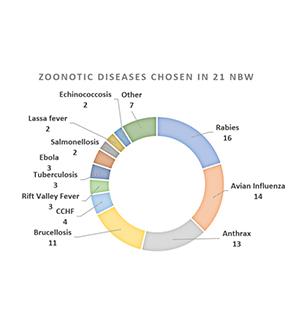
At Human-Animal Interface, Better Collaboration is Needed
June 4, 2019
Surveillance, response and risk communication are some critical points for collaboration between public health and animal health services in management of zoonotic diseases—but interesting early results taken from bridging workshops show participants are scoring their performance in these areas poorly during simulation scenario.
This suggests countries could use more guidance and tools on how to boost collaboration in these domains. WHO, OIE and FAO have recently released the Tripartite Zoonosis Guide, and are now developing operational tools to cover a number of these topics.
National actors from public health and animal health services use an interactive methodology during IHR-PVS National Bridging Workshops (NBWs) in order to evaluate and improve collaboration. Jointly developed by WHO and OIE, it has been used in 24 countries so far.
A NBW includes simulation scenarios for both public and animal health sectors to evaluate collaboration; four to five priority zoonotic diseases are used in each workshop, and are chosen jointly. A first look at the results shows rabies, avian influenza, anthrax and brucellosis are the leading high-priority choices for both sectors: they are far ahead of others and clearly considered a high priority in most countries. Other diseases were chosen a handful of times, including Ebola which was only selected by the three countries who suffered from the 2014-2016 outbreak (Liberia, Sierra Leone and Guinea).
[[{"fid":"3419","view_mode":"default","fields":{"format":"default","alignment":"center","field_file_image_alt_text[und][0][value]":false,"field_file_image_title_text[und][0][value]":false,"external_url":""},"type":"media","field_deltas":{"1":{"format":"default","alignment":"center","field_file_image_alt_text[und][0][value]":false,"field_file_image_title_text[und][0][value]":false,"external_url":""}},"link_text":null,"attributes":{"width":"1000","style":"vertical-align: middle;","class":"media-element file-default media-wysiwyg-align-center","data-delta":"1"}}]]
During the workshops national stakeholders from public health and animal health services discuss how they would realistically manage such scenarios and jointly evaluate the level of their collaboration for 15 areas using a semi-quantitative scale. Using data from 17 NBW with validated reports, the chart below shows the average score (1-10 scale) obtained for each area for all diseases and all countries combined.
Coordination at high level obtains a very high score, but at local level it is one of the most harshly rated areas. Many countries have set-up a One Health supra- or inter-ministerial committee, but the effects may not cascade down to the technical and local levels.
These are just a few of the observations made from very preliminary analysis of the NBW results. An in-depth analysis is underway and will look into what may be the most interesting output of those workshops: the road map of joint activities both sectors agreed to implement together in order to improve their collaboration at the human-animal interface.